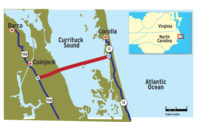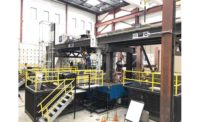Prefabricated segmental bridge designs not only help shave time and money off construction but also may perform well in seismically active regions, according to recent tests conducted by the University of Buffalo’s Dept. of Civil, Structural and Environmental Engineering and its Multidisciplinary Center for Earthquake Engineering Research.
As part of a Federal Highway Administration-funded project exploring the seismic response of Accelerated Bridge Construction systems, the engineering research team in May erected a half-scale, 60-ft-long, eight-segment, post-tensioned superstructure supported by 10-ft, 5-in.-tall hollow piers on 10 x 10-ft concrete foundation blocks. The blocks were mounted on twin shake tables at the university’s Structural Engineering and Earthquake Simulation Laboratory.
Unbonded post-tensioned tendons allowed the test bridge maximum freedom of movement, according to Amjad Aref, a University of Buffalo civil engineering professor and co-principal project investigator. “We wanted to allow the segments to rock or slide relative to each other, which is a very good way to dissipate seismic energy,” Aref says. “Locking segments together with shear keys would focus the load on different components and potentially cause failures.”
Over a three-week period, the 70-ton test structure underwent more than 150 minute-long simulated earthquakes. The tests gradually increased in intensity, with varying levels of horizontal, transverse and vertical motion. In some tests, the shake tables were moved in unison, while other tests simulated seismic waves.
Between the tests, white-noise acoustical measurements checked for any signs of structural fatigue. The final two tests replicated a magnitude-7.0 earthquake, which is the maximum capacity of the shake tables.
“Aside from some minor spalling on the segments, there was no damage to the superstructure from start to finish,” says Aref. “Even when we subjected the test structure to the MCE [maximum credible earthquake] for vertical motion, the segments returned to place with no more than a 1/16-inch sliding offset.”
The simulations answered some questions, but raised others, Aref adds. “There’s no doubt that this design would perform well in a severe seismic environment,” he says. “That’s a credit to the post-tensioning, which held up extremely well.”
However, the tests also revealed an unexpected interaction between rocking and sliding of the segments. “We will need to do some friction tests to model that relationship and help us understand that phenomenon analytically, using finite element simulations,” Aref says.












Post a comment to this article
Report Abusive Comment